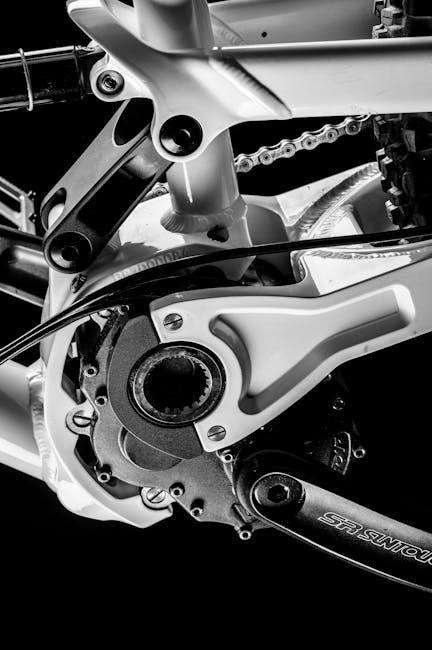Mountain bike wheel sizes significantly impact performance, efficiency, and handling. Different sizes cater to various riding styles and terrains, making the right choice crucial for optimal cycling experiences.
1.1 Overview of Mountain Bike Wheel Sizes
Mountain bike wheel sizes vary, with 26″, 27.5″, and 29″ being the most common. Each size offers unique advantages, such as maneuverability, speed, or stability, catering to different terrains and riding styles. Wheel size selection is influenced by factors like terrain type, bike category, and rider preferences. Understanding these differences is essential for optimizing performance and ensuring compatibility with modern mountain bike designs. This guide explores these options in detail.
1.2 Importance of Choosing the Right Wheel Size
Choosing the right mountain bike wheel size is crucial for optimal performance, efficiency, and handling. The wrong size can lead to poor fit, reduced control, and mechanical inefficiencies. Riders must consider factors like terrain, riding style, and bike compatibility to ensure the best experience. This guide helps cyclists select the ideal wheel size, enhancing stability, speed, and overall riding enjoyment on various trails and conditions.
Common Mountain Bike Wheel Sizes
Mountain bikes typically feature 26-inch, 27.5-inch, or 29-inch wheels, each offering unique advantages for specific riding styles and terrain, ensuring optimal performance and rider comfort.
2.1 26-Inch Wheels: Pros and Cons
26-inch wheels are lightweight and highly maneuverable, ideal for technical terrain and tight corners. They offer excellent acceleration and are easier to handle for shorter riders. However, they can struggle with maintaining speed on smoother trails and may feel less stable at higher speeds compared to larger wheels. Their smaller size also means less rollover capability on rough surfaces, making them less efficient for long-distance riding.
2.2 27.5-Inch Wheels: A Balanced Option
27.5-inch wheels offer a balanced blend of maneuverability and stability, making them versatile for various terrains. They provide better rollover capability than 26-inch wheels while maintaining agility. This size is ideal for riders seeking a middle ground, offering efficient speed on smoother trails and decent handling in technical sections. Their moderate diameter makes them suitable for a wide range of rider heights and riding styles, from cross-country to trail riding.
2.3 29-Inch Wheels: Speed and Efficiency
29-inch wheels excel in speed and efficiency, making them ideal for cross-country and endurance riding. Their larger diameter allows for better rollover on obstacles and maintains momentum on smoother trails. However, their size can make them less maneuverable in tight, technical terrain. They suit taller riders and those prioritizing speed over agility, offering superior performance on flowing singletrack and long-distance adventures. Efficiency and stability at higher speeds are their standout features.

Factors Influencing Wheel Size Selection
Wheel size selection depends on rider height, body proportions, riding style, terrain, and bike frame compatibility, ensuring optimal performance and comfort for diverse mountain biking needs.
3.1 Rider Height and Body Proportions
Rider height and body proportions play a crucial role in selecting the right mountain bike wheel size. Taller riders often benefit from larger wheels, such as 29-inch options, for improved stability and efficiency. Conversely, shorter riders may prefer smaller wheels, like 27.5-inch, for better maneuverability and control. Proper bike fit and frame geometry must also align with wheel size to ensure optimal performance and comfort for varying rider sizes and body types.
3.2 Riding Style and Terrain
Riding style and terrain significantly influence mountain bike wheel size selection. Aggressive downhill riders often prefer 27.5-inch wheels for sharp turns and technical terrain, while cross-country riders favor 29-inch wheels for speed on smooth trails. Enduro riders may opt for a balanced 27.5-inch or 29-inch setup, depending on the mix of climbing and descending. The right wheel size enhances stability, maneuverability, and efficiency for specific riding conditions and preferences.
3.4 Bike Frame and Geometry Compatibility
Bike frame and geometry play a crucial role in determining compatible wheel sizes. Frames are designed to accommodate specific wheel diameters, ensuring proper clearance and handling. Wheel size affects the bike’s wheelbase, standover height, and overall geometry. Riders must ensure their frame is compatible with their chosen wheel size to maintain optimal performance, stability, and rider comfort. Incorrect sizing can lead to poor fit and compromised handling characteristics.
Wheel Size Recommendations for Specific Riding Styles
Mountain bike wheel size recommendations vary by riding style. Cross-country riders often prefer 29-inch wheels for speed, while trail riders favor 27.5-inch for agility, and downhill riders opt for 26-inch durability.
4.1 Cross-Country and Endurance Riding
For cross-country and endurance riding, 29-inch wheels are ideal due to their speed and efficiency. Their larger circumference allows for better roll-over on smooth terrain and maintaining momentum. While they may feel less maneuverable on tight trails, the benefits of reduced effort over long distances make them a favorite for endurance riders seeking optimal performance and comfort during extended rides.
4.2 Trail and All-Mountain Riding
Trail and all-mountain riding often favor 27.5-inch wheels for their balanced agility and control. This size excels on technical terrain, offering precise handling and quicker acceleration. It’s ideal for riders who need versatility, tackling both climbs and descents with confidence. The smaller diameter enhances maneuverability, making it easier to navigate tight trails and obstacles, while still providing enough stability for varied terrain and riding styles.
4.3 Downhill and Freeride
Downhill and freeride disciplines often favor 29-inch wheels for their stability at high speeds and ability to roll over rough terrain effortlessly. The larger diameter provides better momentum and traction, which is crucial for steep, technical descents. While heavier than smaller wheels, the added control and confidence on challenging trails make them the preferred choice for downhill enthusiasts seeking maximum performance and reliability in demanding conditions.

Plus-Size and Fat-Tire Wheels
Plus-size and fat-tire wheels offer enhanced grip and stability on challenging terrain. Wider tires provide better floatation on snow and sand, making them ideal for extreme conditions.
5.1 What Are Plus-Size Wheels?
Plus-size wheels, typically ranging from 2.8″ to 3.2″ in width, offer enhanced traction and control. Designed for versatility, they excel on varied terrains, providing better floatation on snow and sand. Wider tires allow for lower pressure, improving comfort and grip, making them ideal for challenging conditions while maintaining durability and performance.
5.2 Benefits of Fat-Tire Wheels
Fat-tire wheels, typically 3.7″ or wider, provide exceptional traction and stability on loose or uneven surfaces. Their wide surface area enhances floatation on snow, sand, and mud, reducing the risk of sinking or losing control. Lower tire pressure increases grip and comfort, while the large volume improves shock absorption. Ideal for extreme conditions, fat-tire wheels offer unmatched durability and versatility, making them perfect for adventurous riders seeking ultimate performance in challenging terrains.
Wheel Width and Its Impact on Performance
Wheel width significantly affects traction, handling, and tire compatibility. Wider rims provide better stability and cornering grip, while narrower rims optimize speed and efficiency for smoother terrains.
6.1 Narrow vs. Wide Rims
Narrow rims are lighter, enhancing speed and efficiency on smooth terrain, while wide rims improve traction and stability, especially on rough or technical trails. Rider preference and tire width compatibility play a crucial role in choosing between them, as wider rims allow for larger tires, which can enhance grip but may add weight. Balancing these factors ensures optimal performance tailored to specific riding styles and conditions;
6.2 Tire Compatibility and Width
Tire width and rim compatibility are critical for optimal performance. Wider tires (2.3″-2.6″) offer better grip and stability, especially on technical terrain, while narrower tires (2.0″-2.2″) excel on smoother trails. Ensuring the tire width matches the rim size is essential for proper fit and functionality. Compatibility varies by bike design, so checking the manufacturer’s recommendations ensures safety and maximizes the tire’s performance capabilities on different surfaces and conditions.
Rim Materials and Their Effects
Rim materials like aluminum and carbon fiber significantly influence a bike’s performance. Aluminum rims offer durability and affordability, while carbon fiber rims provide lightweight efficiency and improved handling.
7.1 Aluminum vs. Carbon Fiber Rims
Aluminum rims are durable, cost-effective, and widely used, offering consistent performance for most riders. Carbon fiber rims, while more expensive, provide exceptional lightweight properties, improving acceleration and handling. Carbon rims also reduce vibration, enhancing comfort during long rides. However, they are more prone to damage from impacts. The choice between aluminum and carbon fiber depends on budget, riding style, and the need for weight reduction versus durability.

Hubs and Axle Standards
Hubs and axle standards impact a bike’s performance, with options like quick-release and thru-axle affecting stability and compatibility. Modern standards prioritize durability and ease of maintenance.
8.1 Quick-Release vs. Thru-Axle
Quick-release systems offer convenience and ease of use, requiring no tools for wheel removal, while thru-axle systems provide enhanced stability and safety, especially for high-impact riding. Thru-axles are generally more secure and better suited for mountain biking, as they maintain tighter frame-wheel connection, reducing wheel movement under stress. Quick-release systems are lighter but may lack the rigidity needed for aggressive terrain, making thru-axles the preferred choice for durability and performance.
8;2 Hub Compatibility with Different Wheel Sizes
Hub compatibility is crucial for ensuring proper fitment and performance across different wheel sizes. Most modern hubs support multiple wheel sizes, with adjustments made through axle spacing or adapters. Riders should verify hub specifications to confirm compatibility with their desired wheel size, ensuring secure and optimal installation. Proper alignment and fitment are essential for safety and efficiency on the trails.
Tire Pressure and Performance
Proper tire pressure enhances handling, traction, and overall bike performance. It ensures optimal tire deformation, improving control on various terrains and reducing the risk of punctures or rim damage.
9.1 How Tire Pressure Affects Handling
Tire pressure significantly influences a mountain bike’s handling. Properly inflated tires ensure optimal contact with the ground, improving traction and stability. Under-inflation can lead to poor control and increased risk of punctures, while over-inflation reduces grip. Balancing pressure according to rider weight and terrain ensures better maneuverability, absorption of impacts, and overall riding efficiency, making it a critical factor for safety and performance.
Maintenance and Upkeep
Regular maintenance ensures optimal performance and longevity of mountain bike wheels. Clean rims, check tire pressure, and lubricate hubs to prevent wear and tear.
10.1 Tips for Maintaining Your Wheels
Proper wheel maintenance is essential for performance and durability. Regularly clean rims and tires to remove dirt and debris. Check tire pressure daily and adjust according to terrain. Inspect rims for dents or damage, and lubricate hub bearings to ensure smooth rotation. Tighten spokes periodically to maintain wheel trueness. Store bikes in a dry, cool place to prevent rust and corrosion. These simple steps ensure optimal performance and extend wheel lifespan.
Choosing the right mountain bike wheel size is crucial for performance and efficiency, ensuring a tailored riding experience based on terrain and personal preference.
11.1 Final Thoughts on Selecting the Right Wheel Size
Selecting the optimal mountain bike wheel size involves balancing rider height, terrain, and bike geometry. Each size offers unique advantages, so consider your riding style and preferences.Compatibility with frames and components is crucial for performance; Experimenting with different setups can provide insights, ensuring the best fit for your adventures. Ultimately, the right wheel size enhances control, efficiency, and overall cycling enjoyment.
